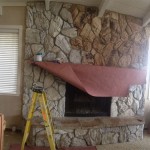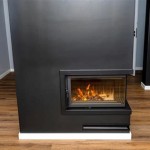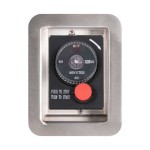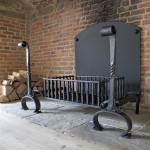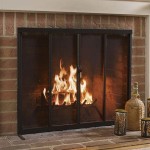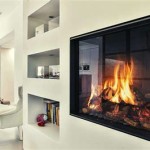Fireplace Vacuum Cleaners: Maintaining Cleanliness and Safety
Fireplaces provide warmth and ambience, but they also generate ash, soot, and debris. Traditional cleaning methods, such as using a shovel and broom, are often inefficient and can spread fine particles into the air. Fireplace vacuum cleaners offer a specialized solution for removing this mess efficiently and safely, contributing to a cleaner home environment and reducing the risk of respiratory irritation and fire hazards.
These specialized vacuums are designed with specific features to handle the unique challenges of fireplace cleanup. They differ substantially from standard household vacuums in terms of filtration, material construction, and intended use. Understanding these differences is crucial for selecting the appropriate tool and ensuring its proper operation and maintenance.
The primary function of a fireplace vacuum is to remove ash, soot, and embers from fireplaces, wood stoves, pellet stoves, and even barbecue grills. These devices are constructed to withstand the abrasive and potentially hot nature of these materials, preventing damage to the vacuum itself and ensuring safe operation. Regular maintenance and the correct use of a fireplace vacuum are essential for prolonging its lifespan and maximizing its effectiveness. Utilizing a standard vacuum for fireplace debris can damage the motor and filters, rendering it unusable and potentially releasing harmful particles into the air.
Key Features of Fireplace Vacuum Cleaners
Fireplace vacuum cleaners stand apart from conventional household vacuums due to several key features adapted to the specific demands of fireplace cleaning. These features contribute to their durability, efficiency, and overall safety.
Filtration System: The most critical difference lies in the filtration system. Fireplace vacuums employ multi-stage filtration, often including a metal mesh pre-filter to capture larger debris, followed by a fine particle filter, sometimes a HEPA (High-Efficiency Particulate Air) filter. HEPA filters are designed to capture at least 99.97% of airborne particles 0.3 microns in diameter. This is crucial for containing the extremely fine ash particles, which can easily pass through standard vacuum filters and become airborne, posing a health risk. The use of HEPA filtration mitigates the dispersal of these harmful particles, contributing to improved indoor air quality. Some models also incorporate a third-stage filter, such as a carbon filter, to absorb odors associated with ash and soot. Regular replacement of filters is necessary to maintain optimal filtration efficiency.
Material Construction: Fireplace vacuums are typically constructed from durable, heat-resistant materials. The canister is often made of metal, such as steel or aluminum, to withstand the abrasive nature of ash and the potential for residual heat. The hose is frequently constructed from a reinforced, heat-resistant material like aluminum or steel, preventing melting or cracking when exposed to embers or hot surfaces. Plastic components, if present, are typically made from high-temperature plastics designed to withstand some degree of heat without deformation. This robust construction is essential for ensuring the longevity and safety of the vacuum when used in demanding conditions.
Motor Design: The motor in a fireplace vacuum is usually designed for high suction power to effectively remove ash and debris. They are also typically equipped with features to prevent overheating, such as thermal protection, as prolonged use can lead to motor damage. Some models incorporate a bypass motor design, which separates the airflow for the motor from the airflow that carries the debris. This prevents ash and soot from directly contacting the motor, extending its lifespan and reducing the risk of damage. The motor's design is integral to the vacuum's ability to efficiently collect debris without compromising its structural integrity.
Proper Usage and Safety Precautions
Operating a fireplace vacuum safely and effectively requires adherence to specific guidelines and precautions. Failure to follow these guidelines can result in damage to the vacuum, injury, or even fire hazards.
Cool Ash Removal: Perhaps the most crucial safety precaution is ensuring that the ash is completely cool before vacuuming. Hot embers or ash can ignite the filter material in the vacuum, leading to a fire. It is generally recommended to wait at least 24-48 hours after the fire has completely extinguished before attempting to vacuum the ashes. Test ash temperature by cautiously holding your hand close to the ashes to feel for any heat emanating from the fireplace or stove. An infrared thermometer can also be used to accurately measure the surface temperature of the ashes. If any heat is detected, allow more time for cooling. Rushing this process can lead to serious consequences.
Avoid Water: Do not use a fireplace vacuum to collect water or other liquids. The combination of water and ash can create a corrosive mixture that can damage the vacuum components. Additionally, introducing water into the electrical components of the vacuum poses a significant electrocution hazard. Fireplace vacuums are designed for dry ash and debris only. If water is present in the fireplace, it should be removed using alternative methods, such as a sponge or wet/dry vacuum specifically designed for liquid pickup.
Regular Filter Cleaning: The filters in a fireplace vacuum require regular cleaning to maintain optimal suction and filtration efficiency. The frequency of cleaning depends on the amount of ash being vacuumed. A clogged filter will reduce the suction power and increase the risk of ash bypassing the filter and being released back into the air. Depending on the filter type, cleaning can involve tapping the filter against a solid surface to dislodge debris, brushing it with a soft brush, or rinsing it with water. If rinsed with water, the filter must be completely dry before being reinstalled. Some filters are disposable and must be replaced periodically. Refer to the vacuum manufacturer's instructions for specific filter cleaning and replacement recommendations.
Selecting the Right Fireplace Vacuum Cleaner
Choosing the right fireplace vacuum cleaner involves considering several factors, including the size of the fireplace, the frequency of use, and individual preferences. Evaluating these factors will help ensure that the selected vacuum is appropriate for the intended application and provides adequate performance.
Capacity: The capacity of the vacuum canister is an important consideration, particularly for those who use their fireplaces frequently. A larger canister will require less frequent emptying, saving time and effort. However, larger canisters can also be heavier and more cumbersome to maneuver. A smaller canister might be suitable for occasional use or smaller fireplaces. Consider the volume of ash typically generated by the fireplace to determine the appropriate canister size. Capacities range from a few gallons to over ten gallons.
Suction Power: Suction power is a critical factor in determining the vacuum's ability to effectively remove ash and debris. Higher suction power will ensure that even fine particles are effectively captured. Suction power is typically measured in Air Watts (AW) or cubic feet per minute (CFM). Higher numbers indicate greater suction power. Consider the type of ash and debris typically encountered. If dealing with heavy, compacted ash, a vacuum with higher suction power will be necessary.
Hose Length and Attachments: The length of the hose and the available attachments can significantly impact the vacuum's versatility and ease of use. A longer hose allows for greater reach, making it easier to clean hard-to-reach areas within the fireplace. Attachments, such as crevice tools and brushes, can be useful for cleaning corners and crevices. Consider the layout of the fireplace and the specific areas that need to be cleaned when evaluating hose length and attachments. Some models offer extendable hoses, providing even greater reach and flexibility.
Fireplace vacuum cleaners are specialized tools designed to safely and efficiently remove ash and debris from fireplaces and stoves. Understanding their key features, proper usage, and selection criteria is crucial for maintaining a clean and safe home environment. By investing in the right vacuum and following appropriate safety precautions, individuals can enjoy the warmth and ambiance of a fireplace without the associated mess and risks.

Scandia Ash Vacuum Wood Fire And Gas Heating

Why You Need A Hot Ash Vacuum Cleaner Mylittlehome Ie

Workpro 5 2 Gallon Ash Vacuum Peak Horsepower Vac Cleaner Wi

Fireplace Ash Vacuum Cleaner 15 L 1200w Non Heat Resistant 00001170 Accessories Pirkti Internetu Prekė Pristatoma Nurodytu Adresu Užsakykite Parduotuvė Rygoje Morex

Ash Vacuum Daewoo

Kaminer Fireplace Vacuum Cleaner Gebruikt Kopen Trading Premium Netbid Industriële Veilingen

Cleaning Your Fireplace And Stove With An Ash Vacuum Cleaner

Valiant 20 Litre Ash Vac Stove Supermarket

Ash Vacuum Cleaner Odk013 20l Heat Resistant Categories Everything For The House Small Household Appliances Cleaners And Fireplace Accessories

Elektrische Koude As Stofzuiger Scsteen Open Haard Bol


